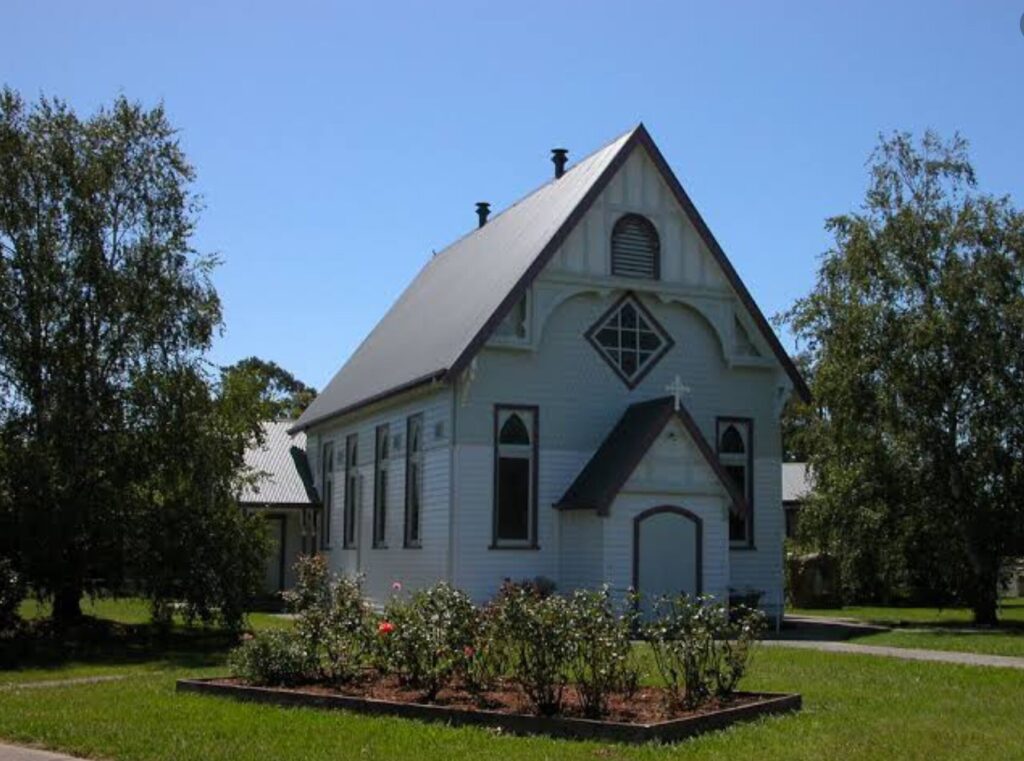PARISH HISTORY

Mass was first celebrated in Trafalgar by Rev. Father Hegarty in 1880 in the chaff house at the railway station. Trafalgar, Yarragon and Moe and surrounding settlements were first all part of the Warragul parish. Three timber churches were built – St John’s Trafalgar in 1890, St Jarlath’s officially opened in Yarragon on April 22nd, 1900 and St. Kieran’s, Moe, on December16th. 1900.
St. John’s was extended in 1906 , and in 1907 the Trafalgar parish was separated from Warragul and incorporated Trafalgar, Yarragon, Moe, Thorpdale, Narracan, Childers and Willow Grove. The first parish priest, Father Hurley, boarded at Mrs. Coghlan’s Coffee Palace until the house next door to the Church was purchased as a Presbytery in 1908. Another timber church, St. Monica’s was opened in Thorpdale in 1916, and remained in use until the 1950s when it was dismantled and sold.
Despite the onset of the Great Depression, the Catholics of the district funded and built a convent on the west side of the church in 1930, and invited the Sisters of St. Joseph to staff a Catholic primary school. The first sisters were Sr. Michael, Superior and music teacher; Sr. Remigius who taught grades 5 to 8, and Sr. Gervasi, the infant teacher. St. Joseph’s school began in classes held in the church and in a room built at the back of the church. Desk tops were added to the pews and had to be removed each Friday, ready for the Sunday Masses, and restored each Monday, for classes throughout the week. This problem was solved when two new class rooms were built on the east side of the church in 1932. The Sisters remained in the parish until 1986, when the education of Catholic students passed into the hands of dedicated lay teachers. The first Acting Principal was Miss Lucy O’Connell who filled the position for 12 months until the first permanent Principal, Miss Mary O’Hea, later named Mrs. Mary Hunt, was appointed. Mrs Patricia Mulqueen is the current principal in 2022.
In 1949, Moe separated off into a new parish of St. Kieran’s, staffed by the Oblate fathers.
In 1954, a new brick War Memorial church was built. It could accommodate 352 people, and was officially opened and dedicated by Rev. Dr. Ryan in 1955. The old church was dismantled in 1960 and rebuilt at Yarragon as St. Jarlath’s hall. It was replaced on the site by a new school building in 1961 which was designed to accommodate 100 children and cost £20,000. It consisted of 4 classrooms, offices and a large shelter area. It has had several additions since then with Commonwealth funding for a library and later a music room. Recently the front offices have been redesigned and a newly designed front façade has been added.

In 1969 the old timber Presbytery was replaced by a new brick presbytery. In 2020 to 2022 extensive repairs have been carried out on the church with new concrete flooring, heating, carpet and sound systems installed, financed by a public appeal and a diocesan loan. The community assistance in helping restore the church was wonderful evidence of the importance placed upon it by the district which it continues to serve. St. Jarlath’s Yarragon is also undergoing repairs and maintenance, and once more, fund raising has shown the town’s appreciation of the building and the service it renders to the local community.
Priests who have ministered in the parish since its beginning, though their dates are not known, were :- Fathers Hurley, Hayes, Shanahan, Gavin, Crowe (later Monsignor), Walsh, Monsignor Daly, Ruth, Monsignor J. O’Meara, Shanley, Readman, Caffrey, O’Kelly, Cusack, O’Connell, Krotwaar, and currently, Bernard Buckley who is Parish Priest.
Brief History of St. Jarlath’s Church
St Jarlath’s Church has stood proudly at the corner of Campbell and Rollo Street in Yarragon since 1899 and has been the gathering place for the Catholic community of the town and district ever since.
This Gothic wooden structure was designed and built by Mr. Leonard J. Flannagan and the parishioners of Yarragon. It was dedicated to St. Jarlath of Tuam, who was the founder of a monastery and a school not far from Galway, Ireland. He was the Abbot- Bishop until he died 550 A.D. (circa) His feast day is June 6th.
St. Jarlath’s Church is cherished and love by its parishioners, local residents and visitors alike. The parish community recognises that the church requires ongoing maintenance to ensure the use of our lovely church into the future.
